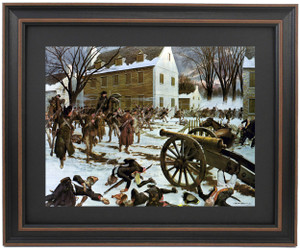
Framed The Burning of the Gaspee by Charles DeWolf Brownell
Patriot GearProduct Overview:
- Proudly handmade in the USA
- Wood frame with mat, glass front, paper duster backing with wire hanger
- Museum quality Giclee digital print using archival paper and inks
- Standard size frame measures approx. 24" wide x 16" tall
- Poster size frame measures approx. 36" wide x 24" tall
Product Details:
The Burning of the Gaspee by Charles DeWolf Brownell captures a pivotal but often overlooked moment in the lead-up to the American Revolution. In the years leading up to the American Revolution, tensions between the American colonies and the British Crown steadily escalated due to unpopular taxes, trade restrictions, and aggressive enforcement of customs laws. One flashpoint occurred in Rhode Island, where the British Royal Navy deployed the HMS Gaspee to patrol Narragansett Bay and crack down on smuggling—a vital economic lifeline for many colonists. The ship’s commander, Lieutenant William Dudingston, became notorious for overstepping his authority, harassing local vessels, and conducting unwarranted searches. His actions enraged Rhode Islanders, who viewed him as a symbol of British overreach and abuse of power.
On the night of June 9, 1772, the Gaspee ran aground near Pawtuxet while chasing a packet boat. Seizing the opportunity, a group of local patriots led by John Brown - rumored to be a member of the Sons of Liberty - assembled a raiding party of about 60 men, rowed out under cover of darkness, wounded Dudingston, and set the ship ablaze. The Gaspee Affair was one of the first violent acts of rebellion against British authority and helped galvanize colonial resistance. Its historical significance lies in how it foreshadowed the coordinated revolutionary action to come. The Crown’s failed attempt to punish the raiders—thanks to a wall of silence among colonists—only fueled resentment and led to the formation of the Committees of Correspondence, a key step toward uniting the colonies in the fight for independence.








